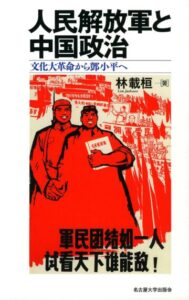
Lim Jaehwan 林載桓
Nagoya University Press 名古屋大学出版会, 2014
Reviewed by Hiroko Naito (Ph.D. candidate in Political Science, Keio University)
This book focuses on the relationship between Mao Zedong (毛泽东) and the People’s Liberation Army (PLA) to explain how a military government was established, continued and eventually dismantled during the Cultural Revolution. The author uses institutionalism and rational choice theory to explain the establishment of military government as a process of the dictator’s profit maximization. If the dictator’s rational choice were unambiguously the establishment of a military government, there would be no argument. However reality is more complicated. There was a huge gap between Mao’s preferences and the institution established. Therefore this book focuses on three questions: 1) what kind of policy Mao chose (institutional change), 2) how his choice worked in practice (institutional execution), 3) cause of a distance between choice and institutional execution. The book argues that military government was not caused by political dualism as most previous studies argued, but by a discrepancy between the dictator’s choices and institutional execution.
This study has three advantages over previous studies. The first is its concrete theoretical framework and innovative perspective. This book successfully shows readers a new interpretation of military government during the Cultural Revolution using institutionalism and rational choice theory, investigating important features such as the personnel management system and organizational restructuring. It clarifies Mao’s perspective (and also Deng’s in part) by using rational choice theory. It is obvious that this book makes a big innovation in the study of Chinese history in Japan.
The second point is that this book demolishes commonly accepted hypotheses by using newly published primary documents such as memoirs of politicians and other restricted publications. The most interesting part of this book is a new interpretation of the Lin Biao (林彪) Incident. According to historical accounts by the Chinese Communist Party, the increase of PLA intervention in politics was correlated with Lin’s political authority. However this book disproves this hypothesis, showing that the political intervention of PLA was designed by Mao. Lin was just an agent who made a connection between Mao and the PLA.
The third point is that this book reveals the mechanisms of how a dictator manages the means of coercion. A trend in institutional studies of dictatorship is a focus on co-optation systems such as parties and congresses. The reason for this trend is greater attention to authoritarian resilience. In China, the authoritarian regime still survives despite the emergence of a multitude of economic interests. A dictator not only has the means of co-optation but also the means of coercion to sustain the regime. Previous studies did not anticipate a contradiction between the dictator and the coercive mechanisms. This book succeeds in revealing how a dictator controls the means of coercion and how difficult it is.
Referring to the superior points noted above, no one can deny the achievement of this book. However some important actors’ perspectives are still missing in this work. The perspectives of the “Gang of Four” and Hua Guofeng (华国锋) are critically important to explain the Cultural Evolution era. This study should have explained the relationship between these important actors and the dictator, even though the main focus of this book is the perspective of the dictator.
In conclusion, this book is one of the best studies of the relationship between the dictator and the PLA during the Cultural Revolution.
